RC2 or RC-2 may refer to:
In cryptography, a block cipher is a deterministic algorithm operating on fixed-length groups of bits, called blocks. They are specified elementary components in the design of many cryptographic protocols and are widely used to encrypt large amounts of data, including in data exchange protocols. It uses blocks as an unvarying transformation.
In cryptography, RC4 is a stream cipher. While it is remarkable for its simplicity and speed in software, multiple vulnerabilities have been discovered in RC4, rendering it insecure. It is especially vulnerable when the beginning of the output keystream is not discarded, or when nonrandom or related keys are used. Particularly problematic uses of RC4 have led to very insecure protocols such as WEP.
R&C, RC, R/C, Rc, or rc may refer to:

Ronald Linn Rivest is a cryptographer and an Institute Professor at MIT. He is a member of MIT's Department of Electrical Engineering and Computer Science (EECS) and a member of MIT's Computer Science and Artificial Intelligence Laboratory (CSAIL). His work has spanned the fields of algorithms and combinatorics, cryptography, machine learning, and election integrity.
Chaffing and winnowing is a cryptographic technique to achieve confidentiality without using encryption when sending data over an insecure channel. The name is derived from agriculture: after grain has been harvested and threshed, it remains mixed together with inedible fibrous chaff. The chaff and grain are then separated by winnowing, and the chaff is discarded. The cryptographic technique was conceived by Ron Rivest and published in an on-line article on 18 March 1998. Although it bears similarities to both traditional encryption and steganography, it cannot be classified under either category.

In cryptography, RC5 is a symmetric-key block cipher notable for its simplicity. Designed by Ronald Rivest in 1994, RC stands for "Rivest Cipher", or alternatively, "Ron's Code". The Advanced Encryption Standard (AES) candidate RC6 was based on RC5.

In cryptography, RC6 is a symmetric key block cipher derived from RC5. It was designed by Ron Rivest, Matt Robshaw, Ray Sidney, and Yiqun Lisa Yin to meet the requirements of the Advanced Encryption Standard (AES) competition. The algorithm was one of the five finalists, and also was submitted to the NESSIE and CRYPTREC projects. It was a proprietary algorithm, patented by RSA Security.
Transport Layer Security (TLS) is a cryptographic protocol designed to provide communications security over a computer network. The protocol is widely used in applications such as email, instant messaging, and voice over IP, but its use in securing HTTPS remains the most publicly visible.

In cryptography, DES-X is a variant on the DES symmetric-key block cipher intended to increase the complexity of a brute-force attack using a technique called key whitening.

In cryptography, RC2 is a symmetric-key block cipher designed by Ron Rivest in 1987. "RC" stands for "Ron's Code" or "Rivest Cipher"; other ciphers designed by Rivest include RC4, RC5, and RC6.
Spritz may refer to:

In cryptography, nothing-up-my-sleeve numbers are any numbers which, by their construction, are above suspicion of hidden properties. They are used in creating cryptographic functions such as hashes and ciphers. These algorithms often need randomized constants for mixing or initialization purposes. The cryptographer may wish to pick these values in a way that demonstrates the constants were not selected for a nefarious purpose, for example, to create a backdoor to the algorithm. These fears can be allayed by using numbers created in a way that leaves little room for adjustment. An example would be the use of initial digits from the number π as the constants. Using digits of π millions of places after the decimal point would not be considered trustworthy because the algorithm designer might have selected that starting point because it created a secret weakness the designer could later exploit.
In cryptography, key whitening is a technique intended to increase the security of an iterated block cipher. It consists of steps that combine the data with portions of the key.
The RC algorithms are a set of symmetric-key encryption algorithms invented by Ron Rivest. The "RC" may stand for either Rivest's cipher or, more informally, Ron's code. Despite the similarity in their names, the algorithms are for the most part unrelated. There have been six RC algorithms so far:
The following outline is provided as an overview of and topical guide to cryptography:
VMPC for cryptography is a stream cipher similar to the well known and popular cipher RC4 designed by Ron Rivest. It was designed by Bartosz Żółtak, presented in 2004 at the Fast Software Encryption conference. VMPC is a modification of the RC4 cipher.

In cryptography, a sponge function or sponge construction is any of a class of algorithms with finite internal state that take an input bit stream of any length and produce an output bit stream of any desired length. Sponge functions have both theoretical and practical uses. They can be used to model or implement many cryptographic primitives, including cryptographic hashes, message authentication codes, mask generation functions, stream ciphers, pseudo-random number generators, and authenticated encryption.

The xor–encrypt–xor (XEX) is a (tweakable) mode of operation of a block cipher. In tweaked-codebook mode with ciphertext stealing, it is one of the more popular modes of operation for whole-disk encryption. XEX is also a common form of key whitening, and part of some smart card proposals.
Yiqun Lisa Yin is a Chinese-American cryptographer and independent security consultant. Yin is known for breaking the SHA-1 cryptographic hash function, for developing the RC6 block cipher, and for her service as editor of the IEEE P1363 project for the standardization of public-key cryptography.